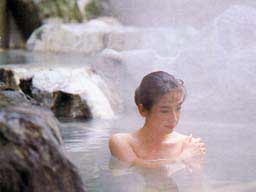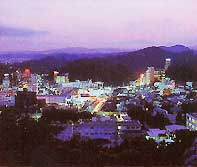
|
Iwaki Yumoto Hot Springs |
|
|
| |


|
|

|
|
1-70, Tennozaki, Jyoubanyumoto-Machi, Iwaki-shi, Fukushima, 972-8321, Japan TEL (+81)-246-43-3017 FAX (+81)-246-44-5691 / E-mail sahako@cocoa.ocn.ne.jp |
 The Legend of the Crane
The Legend of the CraneOnce upon a time two travellers visited a village called Sahako. They came across a wounded crane that had fallen from the sky, treating itself with hot spring water. The merciful travellers could not ignore this sight so they cleaned her wound for her. The crane flew away cheerfully. A few days later, a graceful lady bearing a gift of a scroll visited the couple. The scroll stated that if they created a hot spring in Sahako, they would enjoy a long life and many children. And so, as the story goes, the couple cleared the land and built the first hot spring of Yumoto. |
| The reason why Iwaki Yumoto Springs have been popular for more than 1000 years is because the spring water contains many different healing properties. |
scent^smell of hydrogen sulphide hydrogen ion density^ PH 7.6 water flow^5 tonnes per minute |
 |
||
|
Healing Properties of Iwaki Yumoto Springs aids in the treatment of diseases which are receptive to sulphur spring treatments such as: chronic skin diseases; chronic female disorders; scratches; diabetes; children of delicate health; arterial sclerosis; high blood pressure etc. aids in the treatment of conditions which are receptive to hot spring treatments such as: neuralgia; muscle pain; aching joints; painful stiff shoulders, paralysis, bruises, chronic digestive diseases, haemorrhoids, poor circulation, convalescence, fatigue, general fitness, etc. | |||
 A Time-Honoured Spring
A Time-Honoured SpringAccording to "Enkishiki Shinmei Chou", an ancient book that contains an official collection of data on all aspects of Japanese life, including laws, published in 927 during the Heian Period, introduced Iwaki Yumoto Hot Springs as Mitsunokuni Region`s Shrine of hot springs. This hot spring area is one of the three famous old hot springs together with 'Dogo Spring' in the ancient Iyonokuni Region and 'Arima Spring' in the ancient Settsunokuni Region. During the Nanboku Period, when Yumoto Castle was built, Yumoto Hot Springs became known as the hot springs that provided miraculous cures. It became popular among famous samurai warriors from Kamakura and surrounding areas. In those days, Yumoto Hot Springs, along with Shinano Hot Springs and Natori Hot Springs were known as the three hot springs with medical healing properties in Japan. During the Edo Period, Yumoto Hot Springs were crowded as it was the only town on the seaside road with 51outdoor and 68 indoor bathing facilities. Annual visitors were said to be approximately 20,000. Yumoto was also a popular resting area for the Lords of Sendai and Soma as they made their alternate journeys own to Edo (now Tokyo). Yumoto was also frequently visited by a large number of writers and artists. In year 30 of the Meiji Era (1897), the Joban train line was opened and the number of visitors to Yumoto Hot Springs increased. Even today, Yumoto is the only hot spring area on Japans Railway System (Yumoto Station), as well as the only one on the Joban Express way or route 6. |
|

|